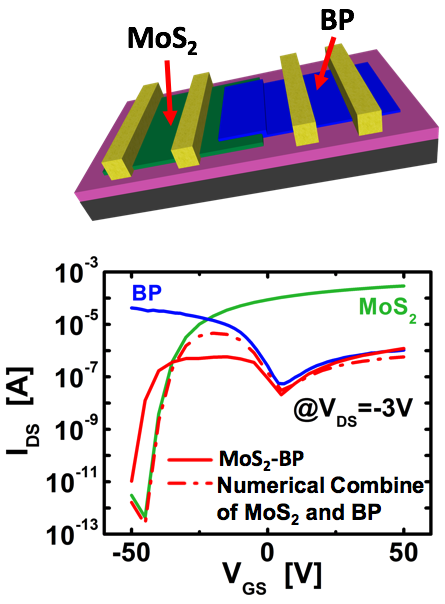Research
Research » 2D Materials » Vertical Transport
Different from 3D materials, 2D materials are composed of stacked atomic layers bonded by van der Waals interaction. The electronic transport in the vertical direction of 2D materials is different from in-plane transport. The following summaries highlight some of the progress made on vertical transport of 2D materials.
MoS2-BP Heterostructures
The nature of 2D materials, like graphene, transition metal dichalcogenides (TMDs), and phosphorene, etc., makes them suitable to form atomically thin heterostructures by stacking dissimilar flakes together, which is not possible in 3D materials. While several heterostructures (MoS2/WSe2, MoS2/BP, MoS2/WS2, etc) have been studied showing strong diode-type rectifications, we have built a truly vertical heterostructure with no lateral component in the transport region. By comparing truly vertical heterostructures and heterostructures with lateral components, it is revealed that those previously studied lateral heterostructures exhibit a Schottky-barrier determined rectification ratio, that is involved in the lateral transport, instead of the p/n junction interface. The gate and drain voltage response of the Schottky-barriers can readily explain the ‘diode’ like characteristics of those structure. Truly vertical heterostructures, however, show much smaller rectification ratios. Our study serves to further understand the transport mechanism in atomically thin 2D heterostructures. (see Nano Lett., 2017, 17 (8), pp 4787–4792).
Authors: Ruiping Zhou, Vaibhav R Ostwal
Pictures adapted with permission from Nano Lett., 2017, 17 (8), pp 4787–4792. Copyright © 2017 American Chemical Society.
Two-dimensional TMDs-based Memory Selectors
Selector device is an individual memory element that can be properly addressed through reading and writing while at the same time the information stored in the resistive random access memory (RRAM) cells of the same array does not get perturbed and power does not get wasted by undesirable leakage through unselected cells. We experimentally demonstrate for the first time a novel two-terminal vertical transition metal dichalcogenide (TMD) based memory selector. It exhibits better overall performance compared with above mentioned two terminal selector candidates and shows the highest vertical current density in TMDs reported so far. (see Device Research Conference (DRC), 2017 75th Annual, 113-114 (2017)).
Authors: Feng Zhang, Yuqi Zhu
©2017 IEEE. Pictures reprinted with permission from Device Research Conference (DRC), 2017 75th Annual, 113-114 (2017) DOI: 10.1109/DRC.2017.7999429



